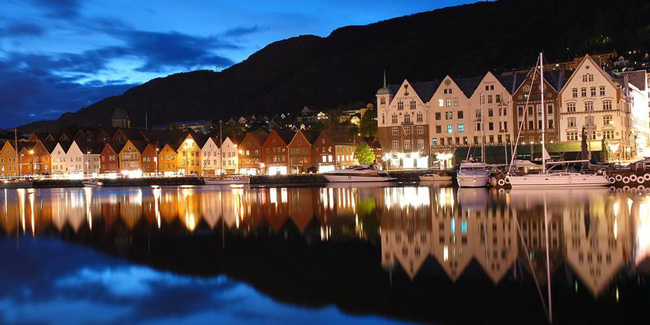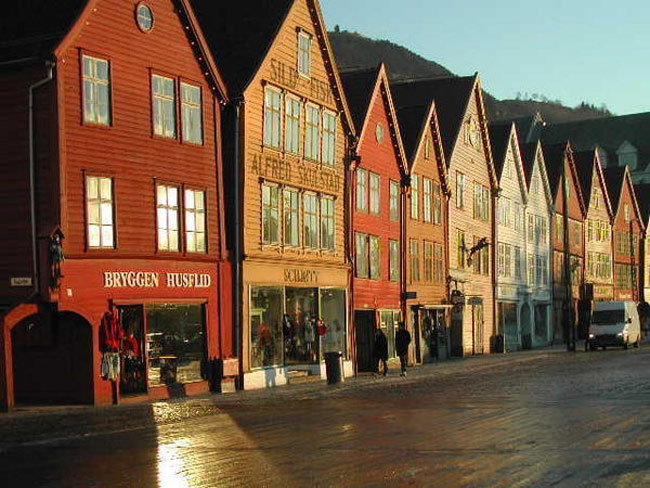Bryggen - Norway
Unesco's Scientific, Educational and Cultural Organization has recognized Norway's Bryggen area as a World Cultural Heritage in 1979.
Bryggen - World cultural heritage in Norway
Bryggen in Norwegian means the pier , in fact the Bryggen area consists of a series of buildings of the Hanse Trade Union.
Bryggen is located on the fjord, leading into the Norwegian city of Bergen. In Bryggen, there are 61 houses built together so far, the remaining houses are still preserved intact. In the history of the Bryggen area, the city of Bergen was founded in 1070. Until 1360, when an office of the Hanse Commercial Union was located in Bryggen area, the city began to grow rapidly and become a zone important commercial center. Bryggen Wharf is a gathering place for merchants from all over the world for 900 years.

The Hanse Union houses are built on the side of the ship to serve merchants who come to trade and trade. These houses are mainly used as a warehouse for goods in the process of trade. For a long time, the warehouses here were always filled with goods, busy docks of ships of other countries to trade and transshipment of goods . From 1360 to 1754, Bryggen became Hanse Alliance headquarters in Norway.

In terms of structure and architecture, the Bryggen houses are built primarily of wood and local materials. The structure of houses was built from the beginning of the long and narrow period, the beams were equal to the pillars of the house. The roof is often clad with tiles together, which makes repairs easier. This structure was built up, repeating to form a unified whole for the Hanse Commercial Union building . Buildings were built opposite the harbor, separated by narrow wooden bars. The fronts of these houses all turn to the harbor, the back of each house has its own yard. At first, these houses were built only of wood, which were later expanded with small fire-resistant warehouses built with stone to preserve valuable goods from fires.


The reason for this was the construction of stone warehouses for fire fighting for goods because in the history of Bergen, there were many fires, most of the buildings built from wood were affected. enjoy. Bryggen also suffered the same fate as one of Bergen's fires. Until 1702 only about 25% of houses and warehouses remained after devastating fires. Most of the houses are now built from the 1901s according to the design of architect Jens Zeltitz Monrad Kielland . At the same time, many wooden houses were damaged during previous fights, but some basements built in the 15th century stone were retained.

By 1955, part of Bryggen's house had been destroyed again. Currently, this land has been used to build Bryggen Museum. The museum is a place to store and display antiques and relics of Bryggen area.
Today, Bryggen is a tourist area with many shops selling souvenirs, restaurants, hotels, etc.

Bryggen's colorful wooden chalets nowadays have become one of the most attractive and attractive tourist destinations in Norway.
The Bryggen houses are recognized by Unesco according to criteria (iii).
Criterion (iii): Bryggen illustrates the existence and operation of a social organization in the 14th century. This port area is also one of the oldest commercial scenes of Northern Europe at the same time. This is also a place with colorful wooden traditional houses that are nowhere else.

Bergen city government has been interested in preserving these buildings since the 1960s and it is thanks to the efforts of conservation and renovation that in 1979, Bryggen was recognized as a Cultural Heritage by Unesco . the world . By 2000, the issue of this heritage management was once more tightened by the City Government, namely material for carefully selected repair and preservation; paint colors to large and small structures in the house must be approved by experts to be repaired and renovated.
In recent years, the number of tourists coming here is increasing. This, though profitable for Bergen's tourism industry, also threatens the environment of its heritage. To overcome this problem, Norway has developed and implemented a protection plan for monuments through creating a large area that functions as a buffer zone. Restaurants, cafes, services for tourism are only allowed to operate in this buffer zone.







- Melting ice makes Norway approach Asia
- Rain worms in Norway
- The ice melts to reveal 2,000 precious objects in Norway's highest mountain range
- Why is Norway voted the happiest country in the world?
- Antiquities appear under the melted snow
- Meteors fell to northern Norway
- Norway successfully tested the first electric aircraft
- The idea of building a daring floating underground tunnel of Norway
- Decode the mystery of light ghost play in Norway
- The strange halo in Norway could be a rocket
- Norway is officially the first country in the world to commit to deforestation
- Real paradise in rural Norway
 Suzhou classic bonsai garden - China
Suzhou classic bonsai garden - China Chau Nguyen Dynasty
Chau Nguyen Dynasty Thai Son Mountain - World Wonder
Thai Son Mountain - World Wonder Ancient villages of Shirakawa-go and Gokayama
Ancient villages of Shirakawa-go and Gokayama